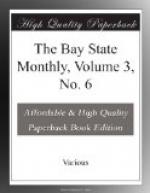The chapters on “Circulation of the Silver Dollar” and “The Trade Dollar” are interesting and timely, inasmuch as the questions considered are now before Congress, or at least with the committees, and legislation of some kind will be demanded within the next year. There is, even now, a proposition embodied in a bill to suspend coinage of the silver dollar, because it has been found impossible to put the great sum coined directly in circulation. A great part of it has been made the basis of silver certificates, a kind of currency that, by and by, will bring distress to commercial interests if the issues are maintained, or if they are materially increased. Mr. Upton treats all these matters with very clear understanding of every question, and with certain facility of expression that appeals directly to the reader who has only common understanding of money affairs. From beginning to end the book is a rich mine of facts, of historical matter, and of statements that have undergone the scrutiny of the wisest financier during the critical period between the appreciation of values, with the disturbing influences of war, and the return of true values with resumption of specie payment which was effected with gold. While the work must have absorbing interest for that extended school of economists that has made finance a special study in the past dozen years, it will prove very useful to representatives in Congress, who may find here in compact form facts of history with which they should have familiar acquaintance before they attempt legislation intended to correct the errors incorporated in our money system.
THE OLD STONE HOUSE. By Anne March (Constance Fenimore Woolson). Boston: D. Lothrop & Co. Price $1.50. This capital story, by one of the brightest American writers of fiction, has been placed by the publishers in their Young Folks’ Library Series, where it ought to find a new lease of popularity. The Old Stone House is the home of five young people, representing three families. They are all orphans, and are living with a widowed aunt, whose single and constant aim is to educate them into real men and women. The young cousins, who dearly love each other, differ in tastes and temperament, but not in such ways as to interfere with each other’s enjoyments. The younger ones are jolly and fun-loving, and no occasion for having a good time is left unimproved. The main interest of the story, however, lies with the eldest of the cousins, Sybil Warrington, a girl of strong feelings but quiet exterior, whose ambition to shine in society is held in check by a feeling that something higher and better is required of her. The story of her struggles is quietly but effectively told, and will have a peculiar interest for young girls. Miss Woolson has written much, and her work has given her a very enviable reputation both in this country and in Europe, but in all her writings there is nothing more earnest.




